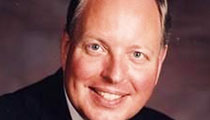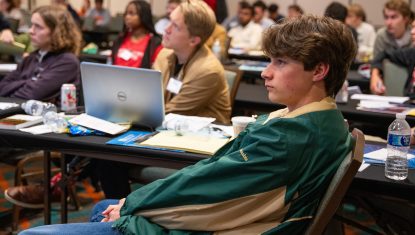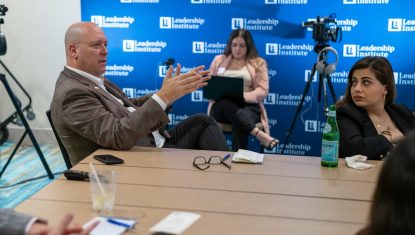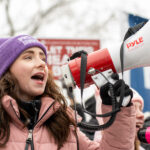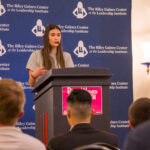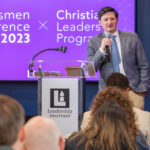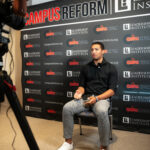Next to Ronald Reagan, no single person has achieved more to advance the cause of American conservatism than Paul Weyrich.
Paul came to Washington 42 years ago to work as press secretary for conservative U.S. Senator Gordon Allott of Colorado. At the time, leftism was riding high.
There were very few conservative op-ed writers. There was no talk radio as we know it today. Fox News and conservative blogs like Townhall and RedState did not exist.
Lionel Trilling wrote at the time that “liberalism is not only the dominant ideology; it’s the only ideology in America.”
Some of the few conservatives who worked in the D.C. area didn’t dare call themselves conservatives.
After Lyndon Johnson’s Great Society, the Nixon/Agnew ticket resulted in another disappointing setback for conservatism. But beginning in the early 1970s, conservatism was on the march. The election of Ronald Reagan in 1980 constituted a major triumph for conservative principles.
… And none of it would have happened without Paul Weyrich. Now it’s time to honor him.
As a congressional staffer, Paul watched the powerful leftist coalition of academics, think tank analysts, members of Congress, White House aides, interest-group officials, and journalists running America and wondered: “Why can’t we put together an operation like that?”
There was, for example, no comparable conservative alternative to the Brookings Institution, the catalyst for many of the legislative successes of the leftists during the 1960s and early 1970s.
Paul Weyrich had been inspired by Barry Goldwater’s principled run for the presidency in 1964. Paul called himself a movement conservative.
You see, Barry Goldwater’s landslide loss in 1964 taught many of us young conservatives a valuable lesson that I still focus on at my Leadership Institute: “Being right, in the sense of being philosophically correct, is not sufficient to win.”
Paul keenly understood this.
When he and I first met in 1968, I saw immediately that Paul was very special: principled, articulate, creative, tenacious, fearless, and wise — in a unique combination.
Over the years I have had the good fortune to know almost all of the most effective conservatives in America. No one else has come close to being as effective as Paul in building the conservative movement. In an astonishing range of activities, Paul’s achievements are spectacular.
Let me start by sharing with you the little-known story of one of Paul’s most important institution-building successes.
Paul and I had been friends for about three years. I was on the senior staff of the American Enterprise Institute (AEI), then the D.C. area’s largest conservative think tank.
When I learned that AEI had deliberately withheld the publication of a powerful study regarding a bill under consideration by the Congress, I privately discussed the matter with Paul. It seemed AEI policy at the time was not to publish studies which might be seen as attempts to affect the outcome in Congress.
After the Senate narrowly defeated the conservatives’ bill, AEI published the study.
When the tardy AEI study arrived at Sen. Allott’s office, Paul himself called AEI president William J. Baroody, Sr., and said, “This is a great study. Why didn’t you publish it when it could do some good?”
Bill Baroody replied that publishing studies which appeared to be attempts to affect pending legislation might endanger AEI’s tax-exempt status.
At that moment, Paul decided that conservatives needed an independent research institute to influence the policy debate as it occurred in Congress — before decisions were made. He envisioned an activist think tank, separate from Congress and not officially tied to any political party.
You’ll be highly interested in what happened next.
Paul contacted Joseph Coors, whom Paul had known when he was a TV newsman in Denver. Joe was president of the Adolph Coors Company in Colorado and one of the best known conservative business leaders in America.
Paul told Joe Coors about AEI’s policy of delaying the publishing of policy studies which might affect pending legislation.
Joe said, “I think I can handle that.” But he got the same story when he phoned AEI’s president.
Joe Coors then called Paul back in Sen. Allott’s office and said, “I want to spend money on the conservative movement. I want to do something.”
Not missing a beat, Paul essentially said, “Have I got an idea for you!”
Later, Joe visited Washington and met with Paul. Casting about for help, Paul arranged for Coors to talk with fellow conservative Lyn Nofziger, who was then President Nixon’s deputy assistant for congressional relations.
Along with Coors and Paul, in Nofziger’s large pastel-blue office in the Old Executive Office Building next to the White House, was Paul’s friend Edwin J. Feulner, Jr.
Ed Feulner was then administrative assistant to Congressman Phil Crane, a staunch conservative from Illinois. Paul and Ed frequently breakfasted together in the basement cafeteria of the U.S. Capitol.
Paul was then age 28, and Feulner was 30.
“So what about AEI?” Joe Coors asked Nofziger.
“AEI?” repeated the curmudgeonly White House aide.
Lyn Nofziger then strolled over to a bookshelf and blew some dust off an AEI study. “That’s what they’re good for — collecting dust. They do great work, but they’re not timely. What we need are studies for Congress while legislation is being considered.”
Coors later told Paul that two things made him decide to go with Paul’s idea, despite the obvious youth of its principals: Lyn Nofziger’s dismissal of AEI as too academic and Paul’s “tremendous business plan.”
And that was the beginning of something big. Paul became the first president of a new conservative think tank, the Heritage Foundation. Ed Feulner later succeeded Paul as president and built Heritage into the conservative powerhouse we know today.
If there had been no Paul Weyrich, there would, in all likelihood, have been no Heritage Foundation. And had there been no Heritage Foundation — and the many other new and improved conservative organizations Paul created or made possible — Ronald Reagan would not have been elected in 1980.
Keep in mind that Goldwater’s humiliating defeat occurred just 16 years prior.
And while Reagan clearly appealed to a wider audience than Goldwater, the rise of conservative organizations allowed Reagan to win by a landslide while Goldwater had lost by a even greater margin in the popular vote. That’s just the start of my story of Paul’s impact.
Paul, Ed, and I were among an informal group brought together by conservative fundraiser Richard Viguerie in 1972. We were determined conservatives who began to discuss how to build a powerful base of conservative activists and leaders who could eventually win in American politics.
Central to our plan was to create new, effective, conservative groups. Paul Weyrich turned out to be, by far, the most successful creator of new groups. Below is only a partial list of the conservative organizations he engendered or was one of the key people in starting:
Heritage Foundation
Free Congress Foundation
Free Congress PAC
Coalitions for America
House Republican Study Committee
Senate Steering Committee
Council for National Policy
International Policy Forum
American Legislative Exchange Council
American Association of State and Local Officials
Conservative Leadership PAC
Paul sparked many people to create and lead a wide variety of other effective, new conservative groups.
Our informal group met frequently throughout the 1970s to brainstorm new ideas and put them into effect.
In one of our discussions, I described theologically conservative Americans as “the largest tract of virgin timber on the political landscape.” All the leftist pastors were already up to their necks in politics, but conservative religious leaders thought any such participation was no part of their calling.
At the time, conservative pastors sat back and allowed the leftists to remove prayer from school, legalize abortion-on-demand and, in general, make government the active enemy of traditional values.
Conservative evangelicals were non-combatants in the political aspects of the culture war. Yet government was successfully assaulting almost everything they held dear.
Paul took the initiative to organize a group of conservative leaders to visit a successful religious broadcaster in Lynchburg, Virginia — to recruit him to lead conservative Christians into political participation.
During their discussion, Paul told the Rev. Jerry Falwell, “Out there is what one might call a moral majority.”
Jerry Falwell suddenly exclaimed, “That’s the name of the organization!”
Many people know what happened from there. (And now you know what Paul Harvey would call “the rest of the story.”) Not long after that, Ronald Reagan became the first presidential candidate to benefit from the support of millions of newly activated, theologically conservative Americans.
Here’s another thing most people don’t know about: Paul’s central role in overturning the defeatist Republican leadership in the Congress.
For decades the House and Senate Republican leadership contentedly accepted their government limousines and gave little thought or effort to overturning the Democrats’ congressional majorities.
Paul saw that only a new generation of conservative Republican congressional leadership could wrest control from the leftist Democrats in charge of both Houses.
Key to that achievement was creation of the House Republican Study Committee and the Senate Steering Committee. Paul and Ed Feulner persuaded some solidly conservative U.S. Representatives and Senators to do that. But that was only the important first step.
Paul then led the bigger and more complex task. It required many steps:
1. To recruit and train a new generation of conservative candidates all across America.
2. To generate political and financial support for those candidates so they could win nomination and election.
3. To identify, recruit, and train conservative Members of both Houses who could eventually become the congressional Republican leaders.
4. To work quietly and systematically to line up support in the House and Senate Republican conferences for action-oriented challengers against the content-free incumbent party leaders.
5. To build up an efficient network of trustworthy conservative congressional staff who would have to do much of the work of advancing conservative principles in congressional activities.
Paul did all of that and more. It was an incredibly complex, massive task.
Paul began a weekly strategy luncheon which he hosted in his office. He recruited as a luncheon regular a very bright new congressman named Newt Gingrich. I was there as Paul first explained to Newt what a “wedge issue” is.
Paul took the lead in an astonishing variety of tasks:
training a new generation of grassroots conservative activists and leaders
recruiting solidly conservative candidates
generating support for conservative candidates in nomination and general-election contests by introducing them to conservative donors and to the leaders of new conservative organizations
helping newly elected conservatives hire solidly conservative staff
lining up support for activist conservatives in party leadership contests in both Houses of Congress.
Of course, most of these activities necessarily take place behind the scenes, so people not directly involved never have learned of Paul’s leadership role in them. Now you know.
Most effective conservatives do know that Paul was the “go to” guy when you wanted to make something happen. Paul’s effectiveness is famous.
Over the last 40 years, I was in uncounted thousands of conservative meetings, large and small, where everyone looked to Paul to put the heat on specific people to do the right thing.
You probably remember the children’s story where some mice were troubled by a cat who was catching and eating many of them. One mouse came up with the great idea of tying a bell around the cat’s neck so they could hear him coming. Another mouse raised the question, “Who shall bell the cat?”
Belling the cat is dangerous business.
Fortunately for all of us, Paul Weyrich was fearless and ready to do whatever must be done to advance conservative principles. He never aspired to win a popularity contest. Regardless of the consequences to himself, Paul kept his commitments, and woe unto anyone who broke his word to Paul.
The truth is that many people are (wisely) afraid of him. Many a waverer was brought back to the straight and narrow for fear of angering Paul.
Serious conservatives treasured Paul’s judgment and the smartest ones often followed his advice. If one wanted support from conservatives, earning Paul’s respect was very, very valuable.
Next, let me tell you one of the best things Paul ever did for us. Having once been invited by mistake to a left-wing coalition meeting, Paul studied how the left operated. Then he adapted for conservatives the techniques for building powerful coalitions.
Paul organized the first successful conservative coalition meetings. Soon Paul’s model began to produce major results in a wide variety of policy areas. Briefly, here’s how it works:
1. Invite people who share common interests and who will commit to take actions to further those causes.
2. Invite people who have the personal ability to make things happen, through their financial resources, their communication vehicles, their grassroots following, their network of contacts, or their expertise.
3. Avoid inviting people who are merely note-takers for others.
4. Prepare an interesting, action-oriented agenda of topics for coalition meetings.
5. Brainstorm ideas for appropriate actions regarding the topics discussed.
6. Call for volunteers to take specific actions.
7. Note those who volunteer to take actions and hold them accountable for doing what they agree to do.
8. Have the meetings chaired by someone who has resources to commit, who has considerable prestige, and whom participants would fear to disappoint.
The beauty of this model is that each person in the coalition remains independent. No one is required to do anything by a vote of the gathering. Yet an enormous amount of action can result.
People are dropped from the meeting if they come only to promote their own projects, never volunteer to take actions to help the projects of others, or consistently fail to do what they volunteer to do.
That all sounds simple, but in practice conservative coalitions pioneered by Paul Weyrich multiplied the effectiveness of conservatives in the public policy process.
Paul created a number of different coalitions and personally chaired his famous Wednesday luncheons when Congress was in session. About sixty people regularly attend.
Other conservatives have replicated Paul’s model effectively for national coalition meetings. Now such coalitions operate locally and do important work in many states.
A little-known aspect of Paul’s career is his huge effort to identify and train pro-freedom activists and leaders in the former Soviet empire.
He understood that the fall of Communist regimes would amount to nothing unless anti-communists there learned how to operate successfully in the democratic process. From the Iron Curtain to far Siberia, Paul brought expert American conservative faculty to teach practical political skills to grassroots activists.
Over several years, Paul personally made more than 40 trips over there.
He identified good people and brought first-class training to them. Conditions were often primitive, and there was more than a little personal danger. But as usual, Paul poured his talent and resources into doing the right thing.
We should thank God that Paul remained active so long in politics. Through his principal organization, the Free Congress Foundation, he did tremendous work on behalf of our country and our conservative principles.
At the end he wrote and published more than ever. Hardly a day passed without powerful, interesting, current quotes from Paul in the print and broadcast media on the hot issues before our country.
Several years ago, Paul had a nasty accident when he slipped on the ice. This left him crippled and in constant pain. Ultimately, doctors removed his legs. In spite of the resultant disability, Paul labors on, always courageous and highly effective.
Still an inspiring movement conservative, Paul continued as an outspoken critic of Republicans and Democrats who don’t advance our economic and social values.
Without Paul Weyrich, there would likely have been no conservative movement worthy of the name — and no Ronald Reagan presidency.
If there were a Mount Rushmore for conservative leaders, Paul’s face would have to be on it.
